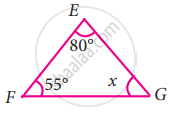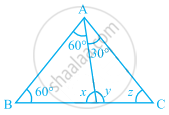Advertisements
Advertisements
Question
Two adjacent angles are equal. Is it necessary that each of these angles will be a right angle? Justify your answer.
Solution
We know,
Two angles are said to be adjacent, if they have a common vertex, a common arm, and their non-common arms are situated on different sides of the common arm.
Also, we know that the linear pair axiom states that, if a ray stands on a line, then the sum of the two adjacent angles so formed is 180°.
It is given to us that the two adjacent angles are equal. Let us assume each of the adjacent angles measures x.
We know that the sum of two adjacent angles is 180°.
⇒ x + x = 180°
⇒ 2x = 180°
⇒ x = 90°
Thus, each of the adjacent angle is 90°.
APPEARS IN
RELATED QUESTIONS
In the following triangle, find the value of x
In ∆ABC, if ∠B is 3 times ∠A and ∠C is 2 times ∠A, then find the angle
How many triangles can be drawn having its angles as 45°, 64° and 72°? Give reason for your answer.
The angles of a triangle are in the ratio 2 : 3 : 4. Find the angles of the triangle.
Triangle DEF of the given figure is a right triangle with ∠E = 90°. What type of angles are ∠D and ∠F?

In a triangle, one angle is of 90°. Then ______.
- The other two angles are of 45° each
- In remaining two angles, one angle is 90° and other is 45°
- Remaining two angles are complementary
In the given option(s) which is true?
The sum of the measures of three angles of a triangle is greater than 180°.
In a triangle ABC, the measure of angle A is 40° less than the measure of angle B and 50° less than that of angle C. Find the measure of ∠A.
The angles of a triangle are arranged in descending order of their magnitudes. If the difference between two consecutive angles is 10°, find the three angles.
In the given figure, find the values of x, y and z.

